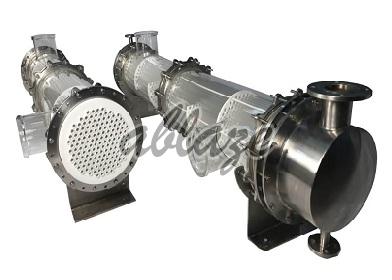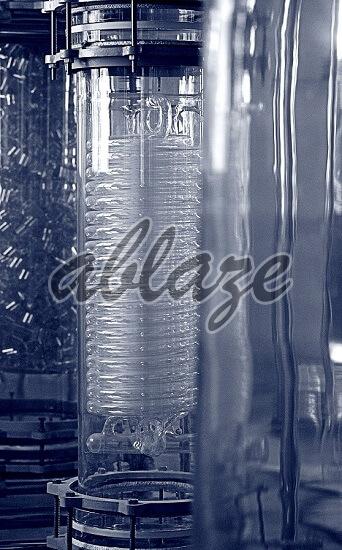Glass Heat Exchangers
Leading Manufacturers, Exporters, Wholesaler, Retailer of Glass Shell and Tube Heat Exchanger and Glass Coil Condenser from Vadodara.
| Business Type | Manufacturer, Exporter, Supplier |
| Color | Grey |
| Automatic Grade | Automatic |
| Area | Upto 50 m2 |
| No. Of Pass | Upto 3 Pass |
| Application | Condensation, Heat Transfer, Cooling, Reboiler |
| Material | Metal |
Shell and Tube Heat Exchangers are one of the most common and versatile types of exchangers used in heat transfer applications. They allow transfer of large amounts of heat in a more compact construction than is possible with conventional coil type heat exchangers. Shell and Tube type Heat Exchangers find application as heaters, coolers, condensers, vaporizers, reboilers, etc.
Pertinent Features of Shell Tube Heat Exchanger
- They have colossal Heat Transfer Surfaces.
- They have high Heat Transfer Coefficients.
- The sides of Shell, as well as Tubes, can be made diffusion and corrosion-resistant.
- Their Modular Design helps make the maintenance simple and also makes the reserves part stocking work efficiently.
- They can handle pressure up to +6 bar G.
- They are perfectly suitable for Pharmaceutical GMP applications that manufacture ultra-pure products.
- They are available with a different working capacity of heat transfer areas ranging from 0.3m2 to 50m2.
- They are highly resistant to corrosion, erosion, and oxidation across the full range of operating temperatures.
Variants
- Translucent reinforced protective coating to prevent from accidents from breakage of glass
- Multi-Pass headers in Metal for more efficient heat transfer
- Vertical installation possible with minor modifications
- GMP, cleanroom models available in all types
- Tubes of exotic materials such as Hastelloy etc. available on request in the same design
- Other process connection sizes can be modified as per application and user requirement
- Tubes of SiC and graphite also available, offering higher thermal conductivity.
Types of Shell And Heat Tube Exchangers
TYPE-I: Both Sides Corrosion Resistant
This is the universal and most common design of shell and tube heat exchanger, where both shell side and tube side are resistant to corrosion. It finds usage in applications such as condensation in the shell side, heat recovery, and cooling in a shell or tubes. With minor modifications, it can also be used as a falling film absorber and falling film evaporator.
TYPE-II: Shell Side Corrosion Resistant
Type-II Heat exchangers are very similar to TypesI but have Metal (Mild steel or Stainless Steel) Headers instead of glass headers. These are used in applications where there is no risk of corrosion at the service/utility side. The process side comes in contact only with the glass shell or PTFE components, and hence can be corrosive. Thus, this design 1’5 generally used for condensation and tempering of corrosive liquids.
TYPE-III: Tube Side Corrosion Resistant
Type-II Heat exchangers are very similar to Type-I but have Metal (Mild steel or Stainless Steel) Headers instead of glass headers. These are used in applications where there is no risk of corrosion at the service/utility side. The process side comes in contact only with the glass shell or PTFE components! And hence can be corrosive. Thus, this design is generally used For condensation and tempering 0f corrosive liquids.
TYPE-IV: Shell Side Corrosion Resistant, High Tube Side Pressure!
A key factor due to which maximum permissible pressure is limited in Shell & Tube Heat Exchangers is the Tube sheet, which cannot withstand a high pressure since it is made of pure PTFE. In applications where corrosion is not an issue at the utility side, a reinforcing plate can be installed at the header side of the PTFE Tube Sheet. This increases the maximum pressure limit up to 6 Bar.
TYPE-V: Tube Side Corrosion Resistant; High Shell Side Pressure!
This design of the Shell and Tube Heat exchanger again uses the reinforcing metal plate to increase maximum permissible operating pressure. However, in this type, the pressure is raised on the shell side since the plate is installed on the shell side of the Tube Sheet and not the header side.
| Business Type | Manufacturer, Exporter, Supplier |
| Material | Glass |
| Application | Industrial Use |
| Weight | 7-105kgs |
| Voltage | 380V |
| Keep the Maximum Coolant Pressure to | 2.7 Bars. |
| Features | Durable |
Coil Condensers
Coil Condensers are commonly used for the process of vapor condensation as well as examines the cooling of liquids. Condensers are manufactured by binding many parallel coils together in a glass shell. These coils are built of different diameters using various bore tubes.
Design of Coil Condenser
The Coil condensers are commonly used to separate or remove heat from refrigeration or an air-conditioning system. Occasionally they are accustomed to the intention of heating the air streams. Coil condensers are among the four essential components in an air-conditioning or the refrigeration cycle. The refrigerant then enters the system as a superheated gas and gets condensed in the coil tubes. The refrigerant then leaves the coil in the form of a liquid.
Methods of Using the Coil Condensers
Vapors from bottom
It is effortless to install the Vapor method over a reactor. However, it may result in the condensate to return at its condensing temperature. You must be careful while working with this method that the condensate must not be in excess, and it must not lead to the blocked coils and create back pressure. Usually, the use of a reflux divider is advised to be installed below the condenser that will take the distillate out.
Boilers
Boilers are usually used for the evaporation process carried out for various liquids by passing the hot steam through the coils. Boilers are manufactured by combining many parallel coils in a glass shell. The coils in the boilers are specially designed to provide you with a much bigger cross-section than Condensers.
Angled Hose Connector Assemblies
Angled hose connector assemblies are usually made from either metal or plastic and must connect the condensers to the flexible hose. These can be provided with a rubber gasket, a mating flange, and nut bolts.
Immersion
Immersion-type heat exchangers are generally used to control the exothermic reaction happening in the glass vessels. Immersion-type heat exchangers can be used along with the vessels that have a bigger and wider bottom outlet. Such heat exchangers come with a central hole in the coil battery so that a stirrer can be mounted at the bottom of the heat exchanger.
In most of the applications, the cooling water is usually used in the coils with a maximum pressure of 2.7 bar g; you can also use them along with the hot steam having a maximum pressure of 3.5 bar g. In the latter case, all the coils are entirely immersed in the liquid. Immersion procedure is not advised to use with the products having crystallization tendency.
Product coolers
Product coolers are generally used to cool various types of liquids that are used for the process of cooling the distillates in the distillation system. Unlike other coil condensers, among the product coolers, the product passes through the coil battery, and the coolant passes through the shell. This transfer process will give the product more time to get cooled.
Preventive measures while using coil condensers
- Let the vapors pass via shell only.
- Keep the maximum coolant pressure to 2.7 bars.
- Coolant flow must be adequate for the process.
- The use of steam in the coil is prohibited.
- Coolant must be heated but not to its boiling point.
- Turn the coolant control valve slowly.
- Let the coolant drain freely.
- You can use coils made from brine in a closed circuit.
- Connect the water main to a flexible hose.
- Ensure water left in the coil doesn’t freeze.
- Condensers must be mounted only in a vertical position
Final Thoughts
Ablaze Export Pvt. Ltd. is one of the leading Coil condensers manufacturers in India. We are into the production of many standard chemical process equipment as well as we also provide customized process equipment. We have years of experience serving customers across India as well as delivering our products across the world.




